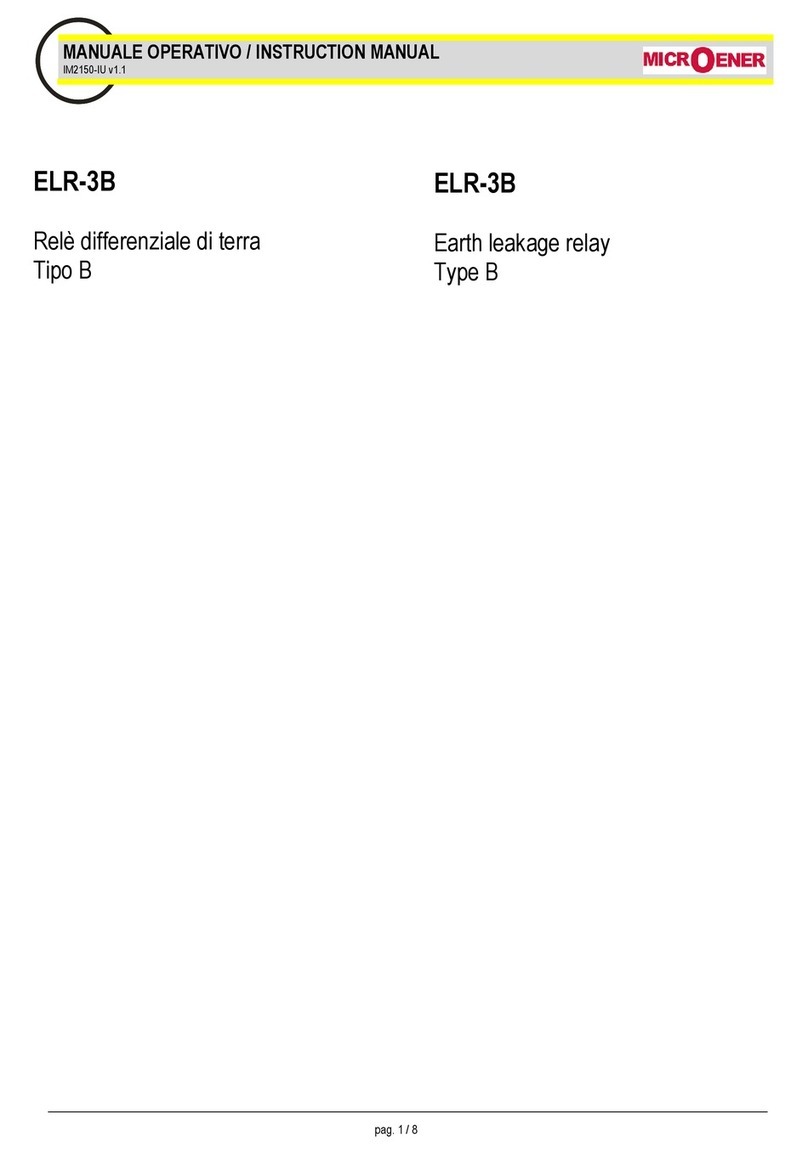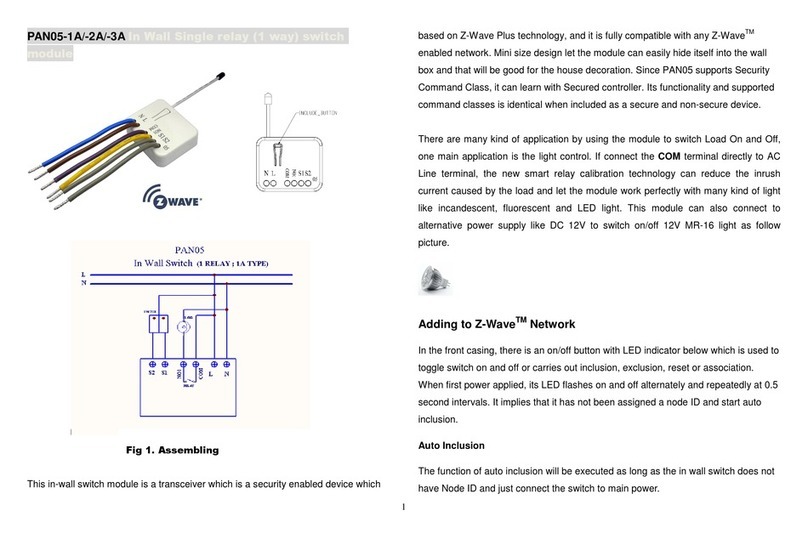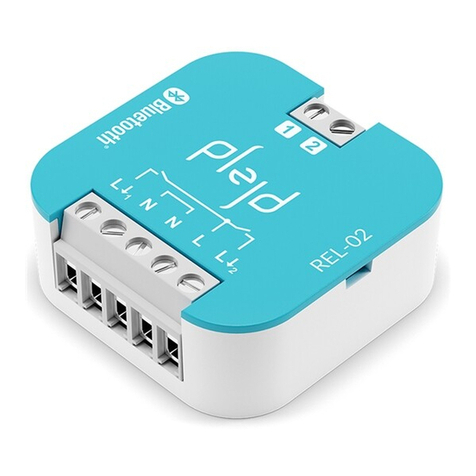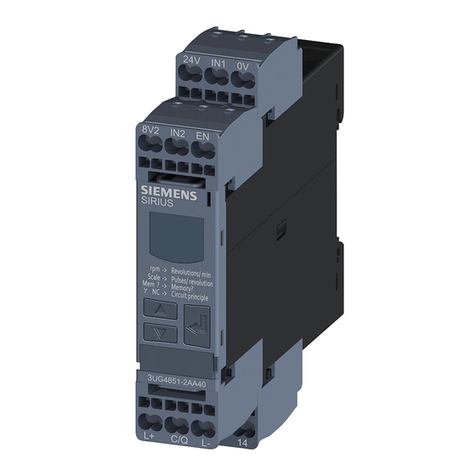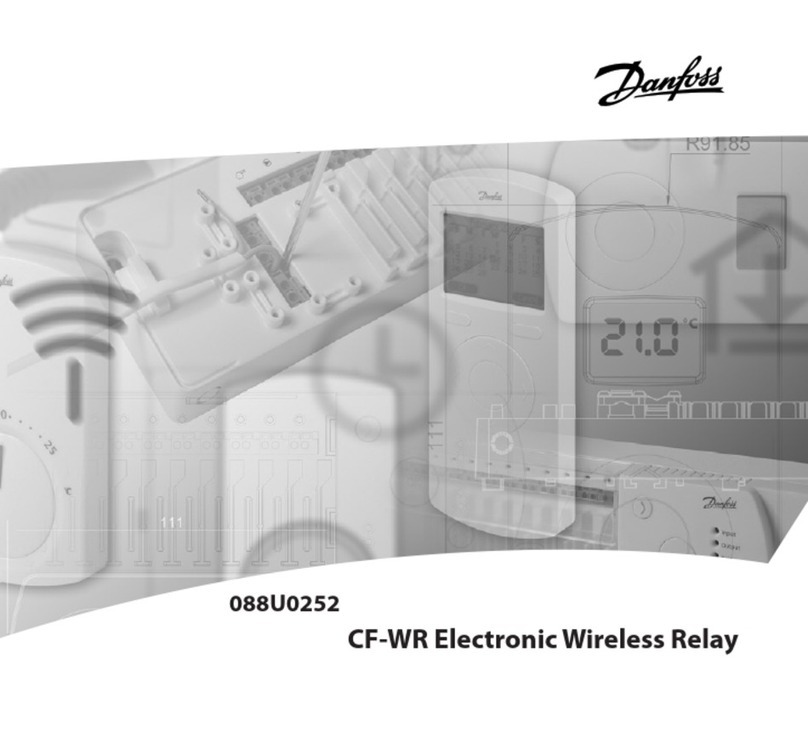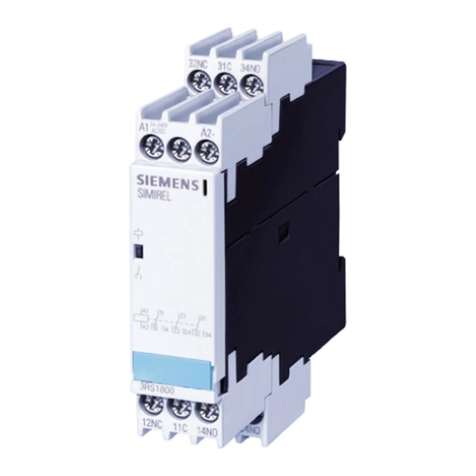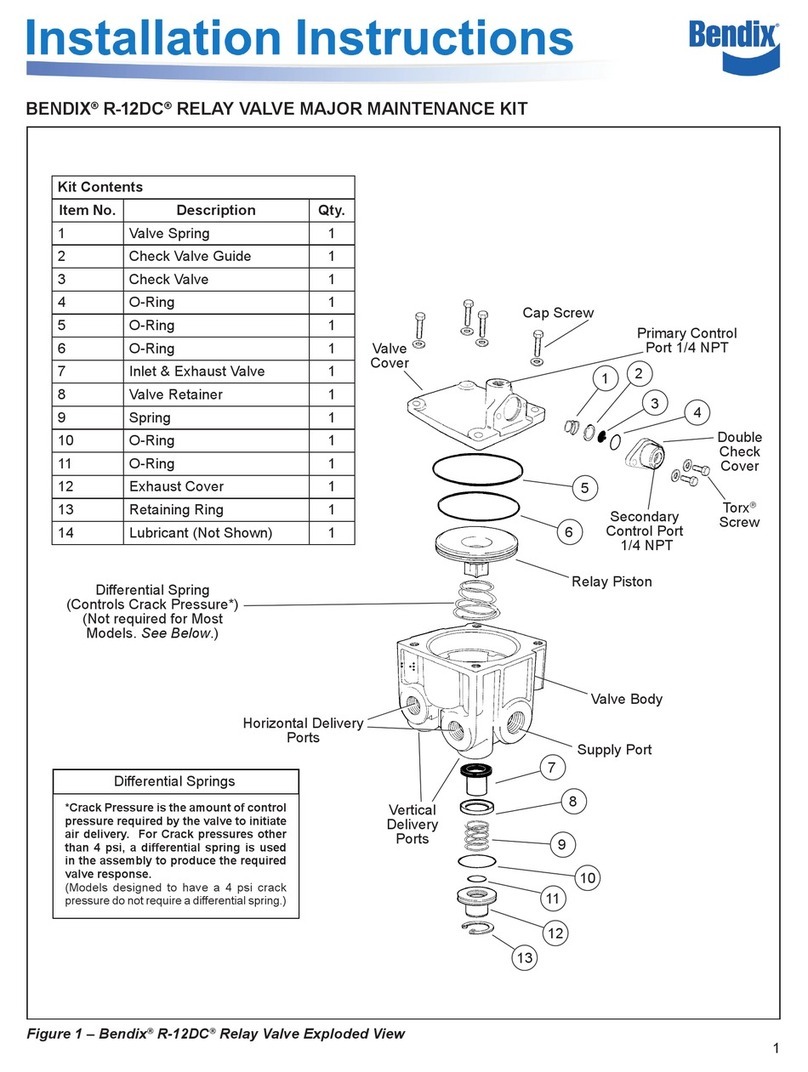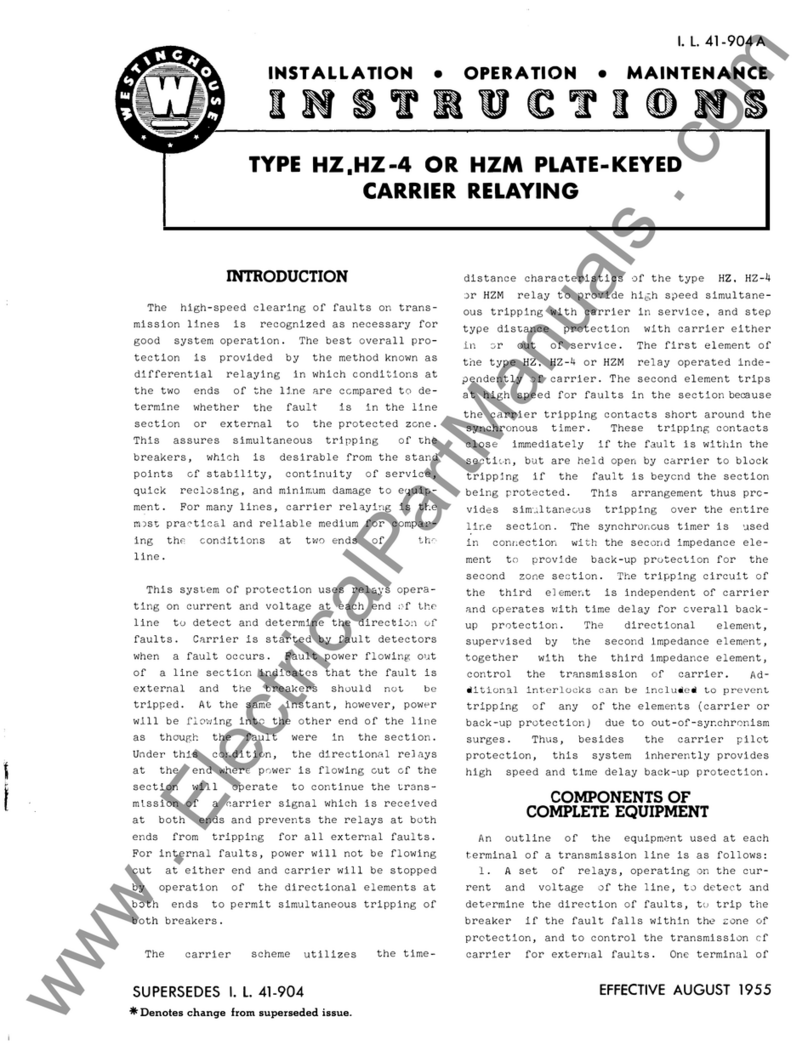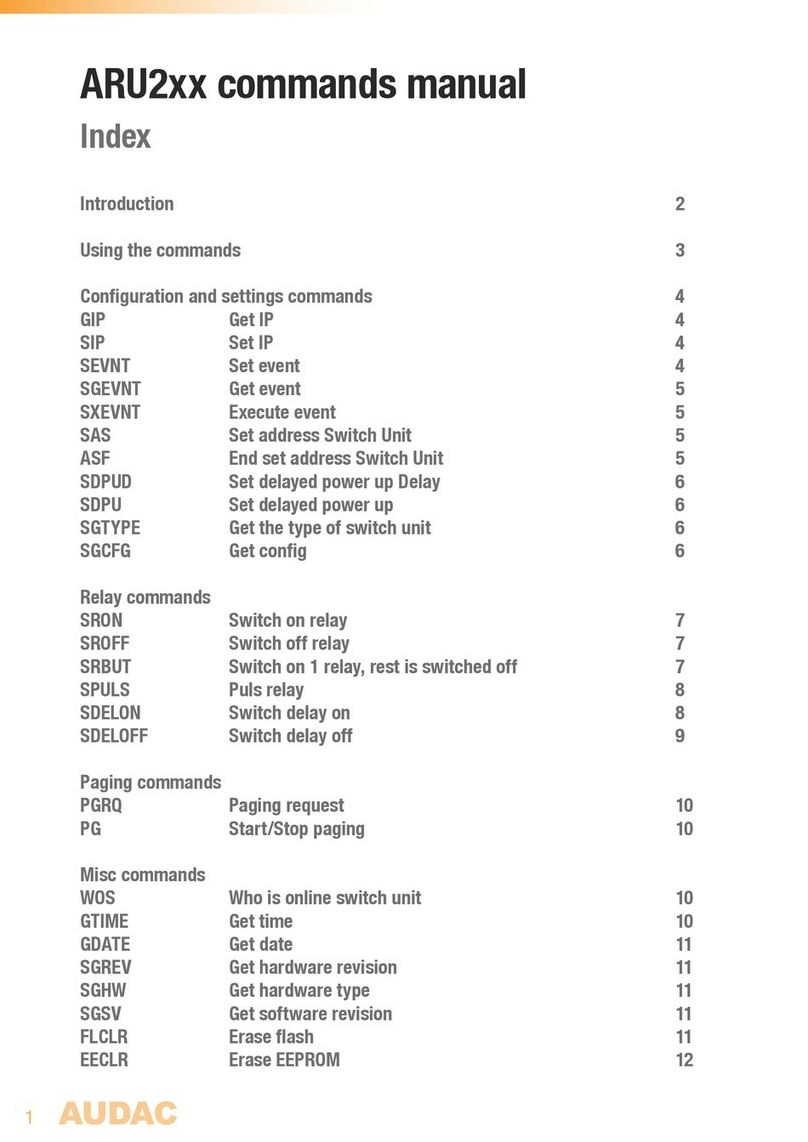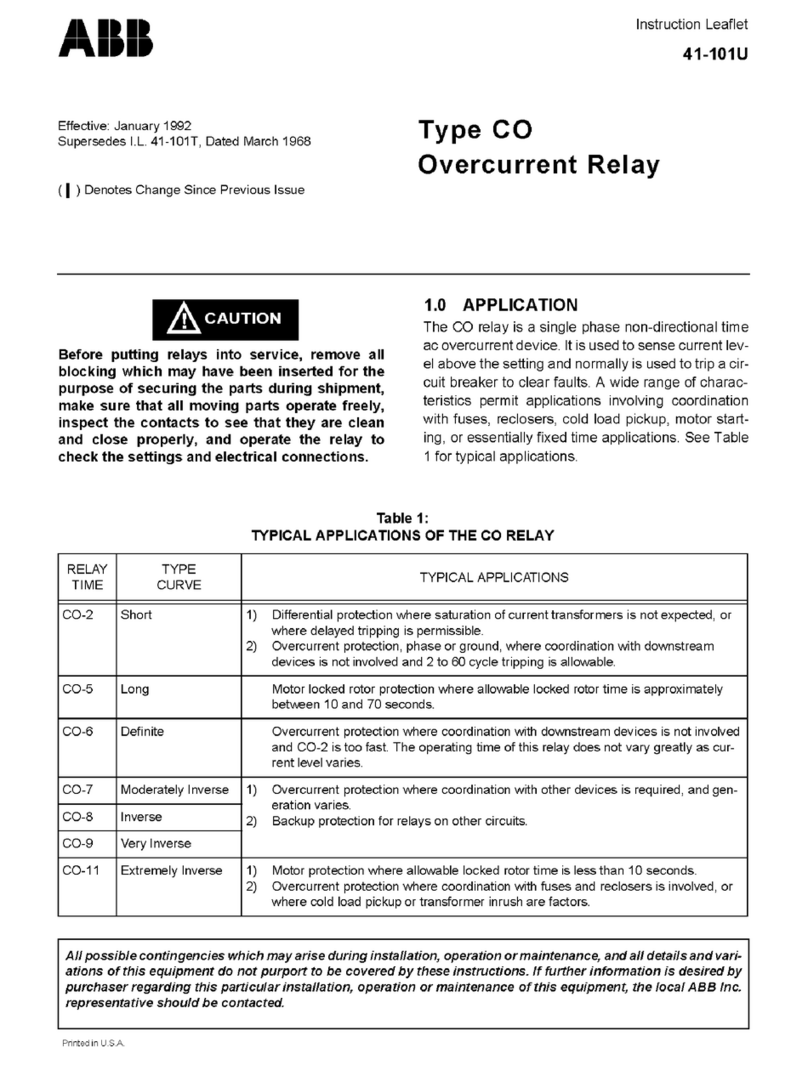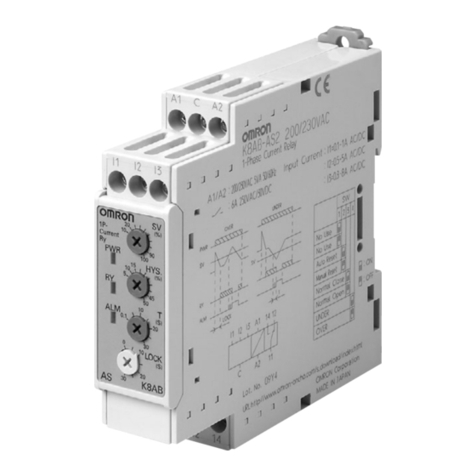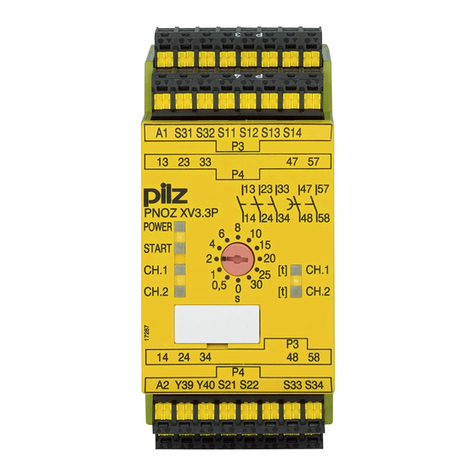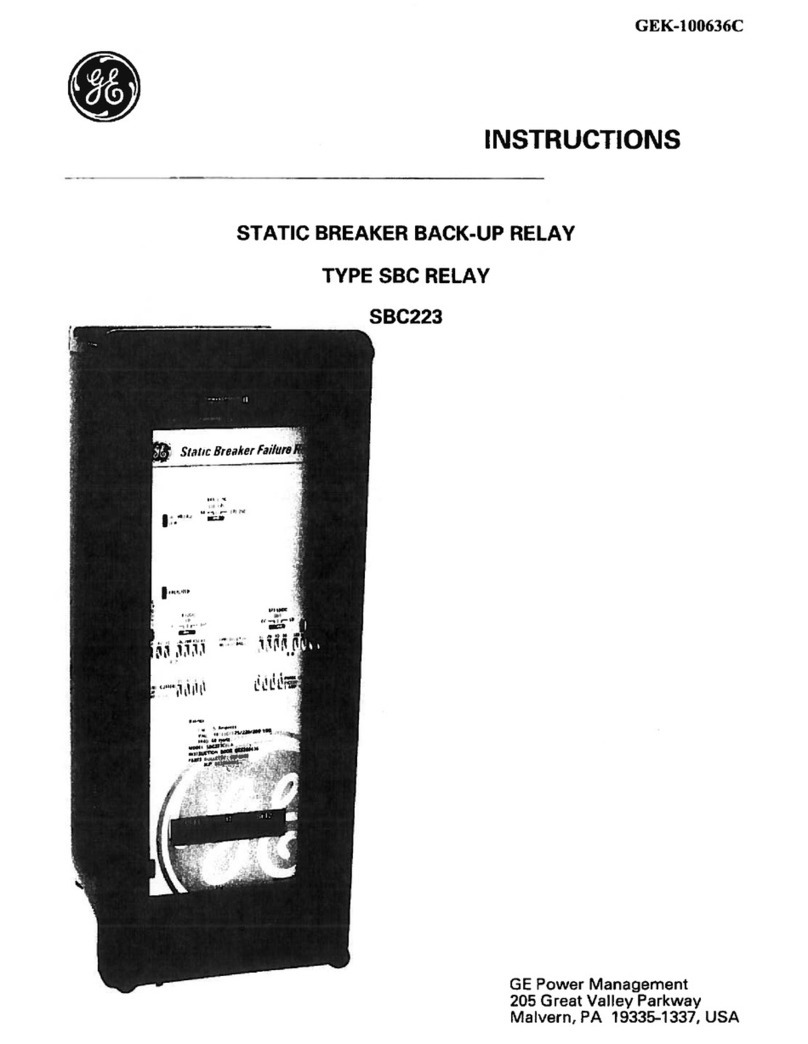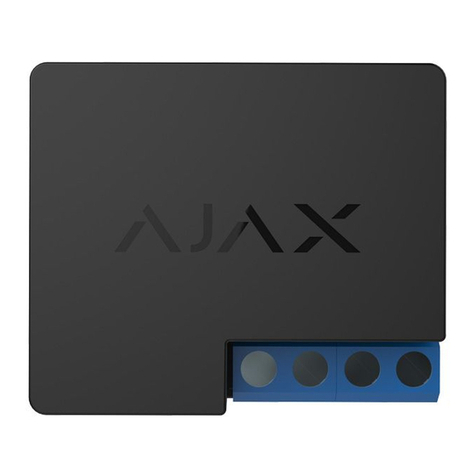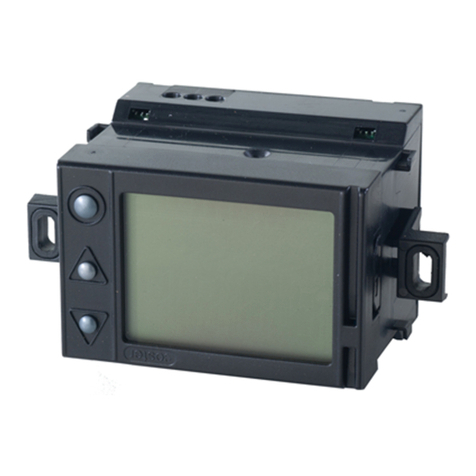MICROENER ULTRA Series User manual

DTMR3-TX
Doc. N° MO-0377-ING
Copyright 2010
Data
01.04.2009
Rev.
0
Pag.
1
of
87
DIGITAL-MULTIFUNCTION
TRANSFORMER DIFFERENTIAL
PROTECTION RELAY
TYPE
DTMR33-TX
(Multiple I/O Boards)
ULTRA Line
OPERATION MANUAL

DTMR3-TX
Doc. N° MO-0377-ING
Copyright 2010
Data
01.04.2009
Rev.
0
Pag.
2
of
87
1. General Utilization and Commissioning Directions ________________________________________4
1.1 - Storage and Transportation _______________________________________________________________________ 4
1.2 - Installation ____________________________________________________________________________________ 4
1.3 - Electrical Connection ____________________________________________________________________________ 4
1.4 - Measuring Inputs and Power Supply ________________________________________________________________ 4
1.5 - Outputs Loading________________________________________________________________________________ 4
1.6 - Protection Earthing _____________________________________________________________________________ 4
1.7 - Setting and Calibration___________________________________________________________________________ 4
1.8 - Safety Protection _______________________________________________________________________________ 4
1.9 - Handling______________________________________________________________________________________ 4
1.10 - Maintenance__________________________________________________________________________________ 4
1.11 - Waste Disposal of Electrical & Electronic Equipment __________________________________________________ 4
1.12 - Fault Detection and Repair ______________________________________________________________________ 5
2. General _________________________________________________________________________5
2.1 - Power Supply__________________________________________________________________________________ 5
3. Front Panel ______________________________________________________________________5
4. Keyboard and Display ______________________________________________________________6
4.1 - Display_______________________________________________________________________________________ 6
5. Icons of Display___________________________________________________________________7
6. Signalization _____________________________________________________________________8
6.1 - Leds Manual Reset _____________________________________________________________________________ 8
6.2 –Display of the last trip ___________________________________________________________________________ 8
7. Cmd (Local Commands) _______________________________________________________9
8. Measure___________________________________________________________________10
9. Max.Val. (Inrush maximum measure values) ______________________________________11
10. Trip Recording (LTrip) _______________________________________________________12
11. Cnt (Counters)_____________________________________________________________14
12. RCE (Recorder Chronological Events) __________________________________________15
12.1 –Events on display ____________________________________________________________________________ 16
13. Sys (System parameters) ____________________________________________________18
14. Settings __________________________________________________________________21
14.1 Modifying the setting of variables__________________________________________________________________ 22
14.2. Password ___________________________________________________________________________________ 23
14.3 –Menu: Communic. (Communication) ____________________________________________________________ 24
14.3.1 –Description of variables ____________________________________________________________________ 24
14.3.2 –Front Panel serial communication port (RS232) _________________________________________________ 24
14.3.3 –Cable for direct connection of Relay to Personal Computer ________________________________________ 24
14.3.4 –Main serial communication port (RS485)_______________________________________________________ 24
14.4 - Menu: LCD__________________________________________________________________________________ 25
14.4.1 –Description of variables ____________________________________________________________________ 25
14.5 - Function: 1d> (First differential element) ___________________________________________________________ 27
14.5.1 - Description of variables ____________________________________________________________________ 27
14.6 - Function: 2d> (Second differential element) ________________________________________________________ 28
14.6.1 - Description of variables ____________________________________________________________________ 28
14.7 - Function: HLock (2nd –5th HarmonicLock)__________________________________________________________ 29
14.7.1 - Description of variables ____________________________________________________________________ 29
14.8 - Function: 1I> (First Overcurrent Element side 1)_____________________________________________________ 30
14.8.1 - Description of variables ____________________________________________________________________ 30
14.8.2 - Algorithm of the time current curves___________________________________________________________ 31
14.8.3 - IEC Curves ______________________________________________________________________________ 32
14.8.4 –IEEE Curves ____________________________________________________________________________ 33
14.8.5 –Blocking Logic (BO-BI)_____________________________________________________________________ 34
14.8.6 - Automatic doubling of Overcurrent thresholds on current inrush _____________________________________ 34
14.9 –Function: 1I>> (Second Overcurrent Element side 1)_________________________________________________ 35
14.9.1 –Description of variables ____________________________________________________________________ 35

DTMR3-TX
Doc. N° MO-0377-ING
Copyright 2010
Data
01.04.2009
Rev.
0
Pag.
3
of
87
14.10 - Function: 2I> (First Overcurrent Element side 2)____________________________________________________ 36
14.10.1 - Description of variables ___________________________________________________________________ 36
14.11 –Function: 2I>> (Second Overcurrent Element side 2)________________________________________________ 37
14.11.1 –Description of variables ___________________________________________________________________ 37
14.12 –Function: do2> (Earth fault element side 2) _______________________________________________________ 38
14.12.1 –Description of variables ___________________________________________________________________ 38
14.13 - Function: Wi (Circuit Breaker maintenance level) ___________________________________________________ 39
14.13.1 - Description of variables ___________________________________________________________________ 39
14.13.2 - Operation (Accumulation of the interruption Energy) _____________________________________________ 39
14.14 - Function: TCS (Trip Circuit Supervision) __________________________________________________________ 40
14.14.1 - Description of variables ___________________________________________________________________ 40
14.14.2 - Operation ______________________________________________________________________________ 40
14.15 - Function: IRF (Internal Relay Fault)______________________________________________________________ 41
14.15.1 - Description of variables ___________________________________________________________________ 41
14.15.2 - Operation ______________________________________________________________________________ 41
14.16 - Function: CB Mngn (Control C/B) _______________________________________________________________ 42
14.16.1 - Description of variables ___________________________________________________________________ 42
14.16.2 - Display Message ________________________________________________________________________ 43
14.17 - Function: Oscillo (Oscillographic Recording) ______________________________________________________ 44
16.17.1 - Description of variables ___________________________________________________________________ 44
14.17.2 - Operation ______________________________________________________________________________ 44
14.17.3 –Available on MSCom2 ____________________________________________________________________ 45
14.17.4 –Setting “User Trigger Oscillo”_______________________________________________________________ 47
14.18 - Function: BrkFail (Breaker Failure)______________________________________________________________ 52
16.18.1 - Description of variables ___________________________________________________________________ 52
14.18.2 - Operation ______________________________________________________________________________ 52
14.19 - Function: ExtReset (External Reset Configuration)__________________________________________________ 53
14.19.1 - Description of variables ___________________________________________________________________ 53
15. User Variables__________________________________________________________________54
16. Input –Output (via software MSCom2)__________________________________________60
16.1 –Digital Inputs ________________________________________________________________________________ 60
16.2 –“DI” Configuration (via MSCom2 software) _________________________________________________________ 61
16.3 –Outputs Relay _______________________________________________________________________________ 64
16.4 - “DO” Configuration ____________________________________________________________________________ 64
17. Date and Time_____________________________________________________________71
17.1 –Clock synchronization _________________________________________________________________________ 72
18. Healthy (Diagnostic Information)_______________________________________________73
19. Dev.Info (Relay Version) _____________________________________________________73
20. Battery________________________________________________________________________74
21. Maintenance ___________________________________________________________________74
22. Power Frequency Insulation Test ___________________________________________________74
23. Basic Relay - Wiring Diagram ______________________________________________________75
23.1 –UX10-4 - Expansion Module - Wiring Diagram (10 Digital Inputs + 4 Output Relays) ________________________ 75
23.2 –14DI - Expansion Module - Wiring Diagram (14 Digital Inputs) __________________________________________ 76
23.3 –14DO - Expansion Module - Wiring Diagram (14 Output Relays) ________________________________________ 76
23.4 –14DO-S - Expansion Module - Wiring Diagram (14 Output Relays)_______________________________________ 77
23.5 –TX3 - Adapter - Wiring Diagram _________________________________________________________________ 77
24. Wiring The Serial Communication Bus _______________________________________________78
25. Basic Relay - Overall Dimensions __________________________________________________79
25.1 –(1 Expansion Module) & (2 Expansion Module) - Overall Dimensions ___________________________________ 80
25.2 –Rack 3U –Overall Dimensions __________________________________________________________________ 81
25.3 –TX3–Overall Dimensions ______________________________________________________________________ 81
26. Direction For Pcb's Draw-Out And Plug-In ____________________________________________82
26.1 - Draw-out____________________________________________________________________________________ 82
26.2 –Plug-in_____________________________________________________________________________________ 82
27. Electrical Characteristics__________________________________________________________83
28. Software & Firmware Version ______________________________________________________84

DTMR3-TX
Doc. N° MO-0377-ING
Copyright 2010
Data
01.04.2009
Rev.
0
Pag.
4
of
87
1. General Utilization and Commissioning Directions
Always make reference to the specific description of the product and to the Manufacturer's instruction.
Carefully observe the following warnings.
1.1 - Storage and Transportation
Must comply with the environmental conditions stated in the product's specification or by the applicable
IEC standards.
1.2 - Installation
Must be properly made and in compliance with the operational ambient conditions stated by the
Manufacturer.
1.3 - Electrical Connection
Must be made strictly according to the wiring diagram supplied with the Product, to its electrical
characteristics and in compliance with the applicable standards particularly with reference to human
safety.
1.4 - Measuring Inputs and Power Supply
Carefully check that the value of input quantities and power supply voltage are proper and within the
permissible variation limits.
1.5 - Outputs Loading
Must be compatible with their declared performance.
1.6 - Protection Earthing
When earthing is required, carefully check its effectiveness.
1.7 - Setting and Calibration
Carefully check the proper setting of the different functions according to the configuration of the
protected system, the safety regulations and the co-ordination with other equipment.
1.8 - Safety Protection
Carefully check that all safety means are correctly mounted, apply proper seals where required and
periodically check their integrity.
1.9 - Handling
Notwithstanding the highest practicable protection means used in designing M.S. electronic circuits,
the electronic components and semiconductor devices mounted on the modules can be seriously
damaged by electrostatic voltage discharge which can be experienced when handling the modules.
The damage caused by electrostatic discharge may not be immediately apparent but the design
reliability and the long life of the product will have been reduced. The electronic circuits produced by
M.S. are completely safe from electrostatic discharge (8 kV IEC 255.22.2) when housed in their case;
withdrawing the modules without proper cautions expose them to the risk of damage.
1.10 - Maintenance
Make reference to the instruction manual of the Manufacturer; maintenance must be carried-out by
specially trained people and in strict conformity with the safety regulations.
1.11 - Waste Disposal of Electrical & Electronic Equipment
(Applicable throughout the European Union and other European countries with separate collection
program). This product should not be treated as household waste when you wish dispose of it. Instead,
it should be handed over to an applicable collection point for the recycling of electrical and electronic
equipment. By ensuring this product is disposed of correctly, you will help prevent potential negative
consequence to the environment and human health, which could otherwise be caused by inappropriate
disposal of this product. The recycling of materials will help to conserve natural resource.

DTMR3-TX
Doc. N° MO-0377-ING
Copyright 2010
Data
01.04.2009
Rev.
0
Pag.
5
of
87
1.12 - Fault Detection and Repair
Internal calibrations and components should not be altered or replaced.
For repair please ask the Manufacturer or its authorized Dealers.
Misapplication of the above warnings and instruction relieves the Manufacturer of any liability.
2. General
Input currents are supplied to 8 current transformers: - three measuring phase current side 1 –
three measuring phase current side 2 - one measuring the earth fault zero-sequence current side 1 -
one measuring the earth fault zero-sequence current side 2.
Current input can be selected 1A or 5A by movable jumpers available on relay cards.
The Measuring Ranges of the different inputs are respectively:
Phase Currents
:
(0.02-25)In
Neutral Current
:
(0.005-4)On
Make electric connection in conformity with the diagram reported on relay's enclosure.
Check that input currents and voltages are the same as reported on the diagram and on the test
certificate.
The auxiliary power is supplied by a built-in interchangeable module fully isolated and self protected.
2.1 - Power Supply
The relay can be fitted with two different types of power supply:
24V(-20%) / 110V(+15%) a.c.
80V(-20%) / 220V(+15%) a.c.
Type
1)
-
Type
2)
-
24V(-20%) / 125V(+20%) d.c.
90V(-20%) / 250V(+20%) d.c.
Before energizing the unit check that supply voltage is within the allowed limits.
3. Front Panel

DTMR3-TX
Doc. N° MO-0377-ING
Copyright 2010
Data
01.04.2009
Rev.
0
Pag.
6
of
87
4. Keyboard and Display
Navigation
menu
By these buttons the options showed in
correspondence on the display are
selected.
Increase
These buttons are used to scroll the items
of the different menus (Local Control,
Measurements, etc).
Decrease
Open
these buttons (when enabled) operate
Circuit Breaker Open/Close control
(see § C/B Mngn)
Close
By the key select the windows showing the ICONS of the available menus.
By the key , select the desired icon and enter by key
The different elements can be selected by the key and .
The details of the individual menus are given in the following paragraphs.
4.1 - Display
The 128x64 pixel LCD display the available information (menu, etc.).

DTMR3-TX
Doc. N° MO-0377-ING
Copyright 2010
Data
01.04.2009
Rev.
0
Pag.
7
of
87
5. Icons of Display
Cmd
Local Commands
Measure
Actual Measurements
MaxVal
Inrush maximum measure values
LTrip
Trips Recorded
Cnt
Overall Counters
RCE
Recorder Chronological Events
Setting
Function Settings
Sys
System Parameters
InfoStatus
Functional Status
Osc
Oscillographic Recorder
TimeDate
Time and Date
Healthy
Diagnostic Information
Info
Info Device

DTMR3-TX
Doc. N° MO-0377-ING
Copyright 2010
Data
01.04.2009
Rev.
0
Pag.
8
of
87
6. Signalization
Four signal leds are provided:
Green Led
Illuminated
-
Relay working properly.
Flashing
-
Internal Relay Fault
Yellow Led
Off
-
No Trip
Illuminated
-
Trip occurred
Flashing
-
Function Timing
Reset from Illuminated status is manual
Red Led
Off
-
C/B Open
Both Flashing
Operation of Trip Circuit
Supervision element.
Illuminated
-
C/B Close
Green Led
Off
-
C/B Close
Illuminated
-
C/B Open
In case of auxiliary power supply failure the status of the leds is recorded and reproduced when
power supply is restored.
6.1 - Leds Manual Reset
For Leds’ manual reset operate as follows:
1
Press “Menu” for
access to the main
menu with icons.
3
Select
“LedClear”
Press “Select” to
execute the
command.
(See § Password).
2
Select icon “Cmd”.
4
When command
has been executed
the display shows
“! Command
Done”;
Press “Select”,
6.2 –Display of the last trip
Beside the signalization of the yellow led “Trip”, indicating a generic function trip, the display shows a
window indicating the last function that was tripped and the number of events that are stored in the
memory. The display will show this window until the reset button or external reset are operated.
1
Press “Menu” to access to the main menu with icons.
Press “Res.” to erase visualization.
Ex. “t1I>” (flashing) is the last trip.

DTMR3-TX
Doc. N° MO-0377-ING
Copyright 2010
Data
01.04.2009
Rev.
0
Pag.
9
of
87
7. Cmd (Local Commands)
“Cmd” allow to operate from relay front face controls like Leds reset, Event clear, etc.
Menu
Description
Password
Led
Clear
Reset of signal Leds
No
Relays
Clear
Manual reset of output relays
No
Breaker
Close
Manual C/B closing
Yes
Breaker
Open
Manual C/B opening
Yes
Breaker2
Close
Manual C/B 2 closing
Yes
Breaker2
Open
Manual C/B 2 opening
Yes
Breaker3
Close
Manual C/B 3 closing
Yes
Breaker3
Open
Manual C/B 3 opening
Yes
Breaker4
Close
Manual C/B 4 closing
Yes
Breaker4
Open
Manual C/B 4 opening
Yes
Event
Clear
Reset of all Events recorded
Yes
HistFail
Clear
Reset of Internal Failure Historic records
Yes
Reset
Wi
Reset Circuit breaker maintenance level
No
Leds
Test
Signal Leds test
No
Force
Osc
Issue a trigger on oschillographic recording
Yes
To operate one command by the Front Face Keyboard, proceed as follows (Led Reset in the present
example).
1
Press “Menu” for access to the main menu with icons.
2
Select “Cmd” icon with pushbutton “Increase” or “Decrease”.
Press “Select” for access.
3
Select with pushbutton “Increase” or “Decrease” the menu “LedClear”.
Press “Select” to execute the command.
(if Password is request, see § Password).
4
When command has been executed the display shows
“! Command Done”; go to “3”.

DTMR3-TX
Doc. N° MO-0377-ING
Copyright 2010
Data
01.04.2009
Rev.
0
Pag.
10
of
87
8. Measure
Real time values as measured during the normal operation.
1
Press “Menu” for access to the main menu with icons.
2
Select “Measure” icon with pushbutton “Increase” or “Decrease”.
Press “Select” for access.
3
Scroll the menu “Measure”with pushbutton “Increase” or “Decrease” to display
the measurement.
Press “Exit” to go to the main menu.
dA
(0 99.99)
In
RMS phase A differential value
dB
(0 99.99)
In
RMS phase B differential value
dC
(0 99.99)
In
RMS phase C differential value
Io2
(0 9999)
A
Earth fault current side 2
1A
(0 9999)
A
RMS value of phase A side 1
1B
(0 9999)
A
RMS value of phase B side 1
1C
(0 9999)
A
RMS value of phase C side 1
2A
(0 9999)
A
RMS value of phase A side 2
2B
(0 9999)
A
RMS value of phase B side 2
2C
(0 9999)
A
RMS value of phase C side 2
d2A
(0 999)
%
2nd harmonic phase A
d5A
(0 999)
%
5th harmonic phase A
d2B
(0 999)
%
2nd harmonic phase B
d5B
(0 999)
%
5th harmonic phase B
d2C
(0 999)
%
2nd harmonic phase C
d5C
(0 999)
%
5th harmonic phase C
IR
(0 99.99)
In
Selected bias through current
Wir
(100 0)
%W
Amount still remaining of permissible interruption energy before Circuit
Breaker maintenance is requested.

DTMR3-TX
Doc. N° MO-0377-ING
Copyright 2010
Data
01.04.2009
Rev.
0
Pag.
11
of
87
9. Max.Val. (Inrush maximum measure values)
Maximum demand values recorded starting from 100ms after closing of main Circuit Breaker
(updated any time the breaker closes).
1
Press “Menu” for access to the main menu with icons.
2
Select “MaxVal” icon with pushbutton “Increase” or “Decrease”.
Press “Select” for access.
3
Scroll the menu “MaxVal”with pushbutton “Increase” or “Decrease” to display
the measure
Press “Exit” to go back to the main menu.
dA
(0 99.99)
In
RMS phase A differential value
dB
(0 99.99)
In
RMS phase B differential value
dC
(0 99.99)
In
RMS phase C differential value
Io2
(0 9999)
A
Earth fault current side 2
1A
(0 9999)
A
RMS value of phase A side 1
1B
(0 9999)
A
RMS value of phase B side 1
1C
(0 9999)
A
RMS value of phase C side 1
2A
(0 9999)
A
RMS value of phase A side 2
2B
(0 9999)
A
RMS value of phase B side 2
2C
(0 9999)
A
RMS value of phase C side 2
d2A
(0 999)
%
2nd harmonic phase A
d5A
(0 999)
%
5th harmonic phase A
d2B
(0 999)
%
2nd harmonic phase B
d5B
(0 999)
%
5th harmonic phase B
d2C
(0 999)
%
2nd harmonic phase C
d5C
(0 999)
%
5th harmonic phase C
IR
(0 99.99)
In
Selected bias through current
Wir
(100 0)
%W
Amount still remaining of permissible interruption energy before Circuit
Breaker maintenance is requested.

DTMR3-TX
Doc. N° MO-0377-ING
Copyright 2010
Data
01.04.2009
Rev.
0
Pag.
12
of
87
10. Trip Recording (LTrip)
Display of the function which caused the tripping of the relay and values of the measurement at the
moment of tripping. The last 10 events are recorded.
The memory buffer is refreshed at each new relay tripping (FIFO logic).
Display
Reading of recorded Trips.
Erase
Clear all Trip recorded.
1
Press “Menu” for access to the main menu with icons.
2
Select “TripRec.” icon with pushbutton “Increase” or “Decrease”.
Press “Select” for access.
3
Select “Display” with pushbutton “Increase” or “Decrease”.
Press “Select” for access.
For “Erase” go to “8”
4
If no trip is recorded the display shows “! No Trips”.
5
If any trip was recorded, select “View” to display the chronological list of the
records.
By the keys “Increase” or “Decrease” select the date of the record to be
checked.
6
Will be shown:
“Descr” the function that caused the event (Example: t1I> = Trip)
“Edge” if the function was tripped (Rise) or reset (Fall)
“Date”, date of trip, year/month/day, hour:minutes:seconds:milliseconds
Press “Value”, for reading the value of input quantities on tripping.

DTMR3-TX
Doc. N° MO-0377-ING
Copyright 2010
Data
01.04.2009
Rev.
0
Pag.
13
of
87
7
Scroll with pushbuttons “Increase” or “Decrease” the available measurements.
Select “Exit” to go back to “5” for another selection, or “2” go back to the main
menu.
8
Select “Erase” with button “Decrease”.
Press “Select” to execute the commands; All Trips recorded are erased.
(if Password is request, see § Password).
9
When command has been executed the display shows “! Command Done”;
Press “Exit” to go back to the main menu.

DTMR3-TX
Doc. N° MO-0377-ING
Copyright 2010
Data
01.04.2009
Rev.
0
Pag.
14
of
87
11. Cnt (Counters)
Counters of the number of operations for each of the relay functions.
By the interface program “MSCom 2” it is possible to individually reset the counters and set an initial
starting value.
Display
1dA>
0
Operations counters
Low set differential first element phase A
1dB>
0
Operations counters
Low set differential first element phase B
1dC>
0
Operations counters
Low set differential first element phase C
2dA>
0
Operations counters
High set differential first element phase A
2dB>
0
Operations counters
High set differential first element phase B
2dC>
0
Operations counters
High set differential first element phase C
1I>
0
Operations counters
First overcurrent element side 1
1I>>
0
Operations counters
Second overcurrent element side 1
2I>
0
Operations counters
First overcurrent element side 2
2I>>
0
Operations counters
Second overcurrent element side 2
do2>
0
Operations counters
Earth fault element side 2
IRF
0
Operations counters
Internal Relay Fault
TCS
0
Operations counters
Trip Circuit Supervision
BrkF
0
Operations counters
Breaker failure to open
Wi
0
Operations counters
Circuit Breaker maintenance alarm
Aut Op
0
Operations counters
Automatic C/B Openings
Aut CL
0
Operations counters
Automatic C/B Closings
Man Op
0
Operations counters
Manual C/B Openings
Man CL
0
Operations counters
Manual C/B Closings
OvrOp
0
Operations counters
Overall C/B Openings total (Man+Aut)
OvrCL
0
Operations counters
Overall C/B Closings total (Man+Aut)
1
Press “Menu” for access to the main menu with icons.
2
Press “Counter” for access.
3
Press “Display” for access.
4
Display of the number of operations of each individual function.
With pushbuttons “Increase” or “Decrease” scroll the parameters
Press “Exit” go back to “3”.

DTMR3-TX
Doc. N° MO-0377-ING
Copyright 2010
Data
01.04.2009
Rev.
0
Pag.
15
of
87
12. RCE (Recorder Chronological Events)
Display of the function which caused any of the following events: - Status change of digital
Inputs/Outputs. - Start of protection functions –Trip of protection function –Function reset.
The last 100 events are recorded.
The memory buffer is updated at each new event.
Display
Reading events recorded.
Erase
Clear all events recorded.
1
Press “Menu” for access to the main menu with icons.
2
Select “Events” icon with pushbutton “Increase” or “Decrease”.
Press “Select” for access.
3
Select “Display”with pushbutton “Increase” or “Decrease”.
Press “Select” for access.
For “Erase” go to “7”
4
If no event is recorded the display shows message “! No Events”.
5
If any event was recorded, select “View” to display the chronological list of the
records.
By the keys “Increase” or “Decrease” select the date of the record to be
checked.
6
Will be shown:
“Descr” the function that caused the event
(Example: 1I> = Start, t1I> = Trip)
“Edge” if the function was tripped (Rise) or reset (Fall)
“Date”, date of trip, year/month/day, hour:minutes:seconds:milliseconds
7
Select “Erase” with button “Decrease”.
Press “Select” to execute the commands; All Events recorded are erased.
(if Password is request, see § Password).
8
When command has been execute the display shows “! Command Done”;
Press “Exit” to go back to the main menu.

DTMR3-TX
Doc. N° MO-0377-ING
Copyright 2010
Data
01.04.2009
Rev.
0
Pag.
16
of
87
12.1 –Events on display
Functions
Events
Displayed
Events Description MScom2
Status
1d>
R1d>
Start
first differential elelement phase R
Rise
Fall
tR1d>
Trip
first differential element phase R
Rise
Fall
S1d>
Start
first differential element phase S
Rise
Fall
tS1d>
Trip
first differential element phase S
Rise
Fall
T1d>
Start
first differential element phase T
Rise
Fall
tT1d>
Trip
first differential element phase T
Rise
Fall
2d>
R2d>
Start
second differenti alelement phase R
Rise
Fall
tR2d>
Trip
second differential element phase R
Rise
Fall
S2d>
Start
second differential element phase S
Rise
Fall
tS2d>
Trip
second differential element phase S
Rise
Fall
T2d>
Start
second differential element phase T
Rise
Fall
tT2d>
Trip
second differential element phase T
Rise
Fall
HLock
2HRL
Phase R
second harmonic lock
Rise
Fall
5HRL
Phase R
fifth harmonic lock
Rise
Fall
2HSL
Phase S
second harmonic lock
Rise
Fall
5HSL
Phase S
fifth harmonic lock
Rise
Fall
2HTL
Phase T
second harmonic lock
Rise
Fall
5HTL
Phase T
fifth harmonic lock
Rise
Fall
2HReduct
Second harmonic reduction level
Rise
Fall
5HReduct
Fifth harmonic reduction level
Rise
Fall
1I>
1I>
Start
First overcurrent element
Side 1
Rise
t1I>
Trip
First overcurrent element
Side 1
Rise
Fall
1I>>
1I>>
Start
Second overcurrent element
Side 1
Rise
t1I>>
Trip
Second overcurrent element
Side 1
Rise
Fall
2I>
2I>
Start
First overcurrent element
Side 2
Rise
t2I>
Trip
First overcurrent element
Side 2
Rise
Fall
2I>>
2I>>
Start
Second overcurrent element
Side 2
Rise
t2I>>
Trip
Second overcurrent element
Side 2
Rise
Fall
do2>
do2>
Start
Earth Fault element
Side 2
Rise
tdo2>
Trip
Earth Fault element
Side 2
Rise
Fall
Wi
tWi>
Circuit breaker maintenance level
Rise
TCS
TCS
Start
trip coil supervision
Rise
tTCS
Trip
trip coil supervision
Rise
Fall
IRF
IRF
Start
Internal Relay Failure
Rise
tIRF
Trip
Internal Relay Failure
Rise
BF
tBF
Trip
Breaker Failure
Rise
Fall

DTMR3-TX
Doc. N° MO-0377-ING
Copyright 2010
Data
01.04.2009
Rev.
0
Pag.
17
of
87
Functions
Events
Displayed
Events Description MScom2
Status
L/Rdisc.
Local/Remote signal Discrepancy
Rise
manOpKey
Circuit Breaker intentional open by Key
Rise
manOpLocC
Circuit Breaker intentional open by local command
Rise
manOpRemC
Circuit Breaker intentional open by remote command
Rise
manOpExtIn
Circuit Breaker intentional open by external input
Rise
ManOpExternal
Circuit Breaker intentional external open
Rise
manClKey
Circuit Breaker intentional close by Key
Rise
manClLocC
Circuit Breaker intentional close by local command
Rise
manClRemC
Circuit Breaker intentional close by remote command
Rise
manClExtInp
Circuit Breaker intentional close by external input
Rise
ExterManCh
Circuit Breaker intentional external close
Rise
CB-Fail
Circuit Breaker failure
Rise
Fall
0.D0
Digital Input on Main Relay
Rise
Fall
----
0.D4
1.D1
Digital input on Expansion Board 1
Rise
Fall
----
1.D15
2.D1
Digital input on Expansion Board 2
Rise
Fall
----
2.D15
0.R1
Output relay on Main Relay
Rise
Fall
----
0.R6
1.R1
Output relay on Expansion Board 1
Rise
Fall
----
1.R14
2.R1
Output relay on Expansion Board 2
Rise
Fall
----
2.R14
UpDateMon
Monitor Update
Rise
Fall
IPU boot
IPU boot
Rise

DTMR3-TX
Doc. N° MO-0377-ING
Copyright 2010
Data
01.04.2009
Rev.
0
Pag.
18
of
87
13. Sys (System parameters)
Setting of system parameters.
CT&PTs
Phase CT
Side 1
Prim.
1000
A
(1 9999)
step
1
A
Sec.
1
A
(1 / 5)
(1)
Phase CT
Side 2
Prim.
1000
A
(1 9999)
step
1
A
Sec.
1
A
(1 / 5)
(1)
Neut.CT
Side 1
Prim.
1000
A
(1 9999)
step
1
A
Sec.
1
A
(1 / 5)
step
(1)
Neut. CT
Side 2
Prim.
1000
A
(1 9999)
step
1
A
Sec.
1
A
(1 / 5)
step
(1)
Nom.Val.
fn
50
Hz
(50 / 60)
(System Rated Values)
It2
1000
A
(1 9999)
1
A
1V
10.00
kV
(0.10 655.00)
0.01
kV
2V
10.00
kV
(0.10 655.00)
0.01
kV
Sys Options
Alfa
Yy6
[Yy0 / Yy6 / Yd1 / Yd5 / Yd7 / Yd11 / Ddo
/ Dd2 / Dd4 / Dd6 / Dd8 / Dd10 / Dy1 /
Dy5 / Dy7 / Dy11 / Yz1 / Yz5 / Yz7 /
Yz11]
(Vector Goup)
Setup Group
Group
1
(1 / 2)
13.1 –Description of variables
fn
:
Nominal Frequency
It2
:
Primary nominal current side 2
1V
:
Nominal Voltage Side 1
2V
:
Nominal Voltage Side 2
Alfa
:
Vector Group
Group
:
Group settings

DTMR3-TX
Doc. N° MO-0377-ING
Copyright 2010
Data
01.04.2009
Rev.
0
Pag.
19
of
87
(1) Move the switch in the corresponding founding to the required input current as herebelow shorted.
1
Press “Menu” for access to the main menu with icons.
2
Select “Sys” icon with pushbuttons “Increase” or “Decrease”.
Press “Select” for access.
3
Select “CT&PTs”.
Press “Select”for access.
4
Select “Phase CT site 1”.
Press “Select” for access.
5
Select “Prim.” to modify the primary value of Phase CT, or press “Decrease”
and select “Sec.” to modify the secondary value of Phase CT.
Press “Modify” to modify the parameter.
(if Password is request, see § Password).
6
The value appear as bold figure.
Use pushbuttons “Increase” or “Decrease”to set the value.
Press “Write” to confirm the value

DTMR3-TX
Doc. N° MO-0377-ING
Copyright 2010
Data
01.04.2009
Rev.
0
Pag.
20
of
87
7
The value is now set.
To set a new value return to the point “5”.
Press “Exit”.
8
The display show “Confirm the change?”.
Choose “Yes ” to convalidate the changes.
Choose “No ” to don’t confirm the changes.
After set confirmation (or non confirmation) the display goes back to point “4”.
9
To modify the input quantities, select with pushbutton “Decrease”,
“Nom.Val.”.
Press “Select” for access.
10
To set the input quantities see points “5-6-7-8” .
11
To select the Vector Group press “Sys.Options”.
Press “Select” for access.
12
To set Vector Group see points “5-6-7-8” .
13
To select the Active Bank of setting press “SetUp Group”.
14
To set the Group active see points “5-6-7-8” .
This manual suits for next models
1
Table of contents
Other MICROENER Relay manuals
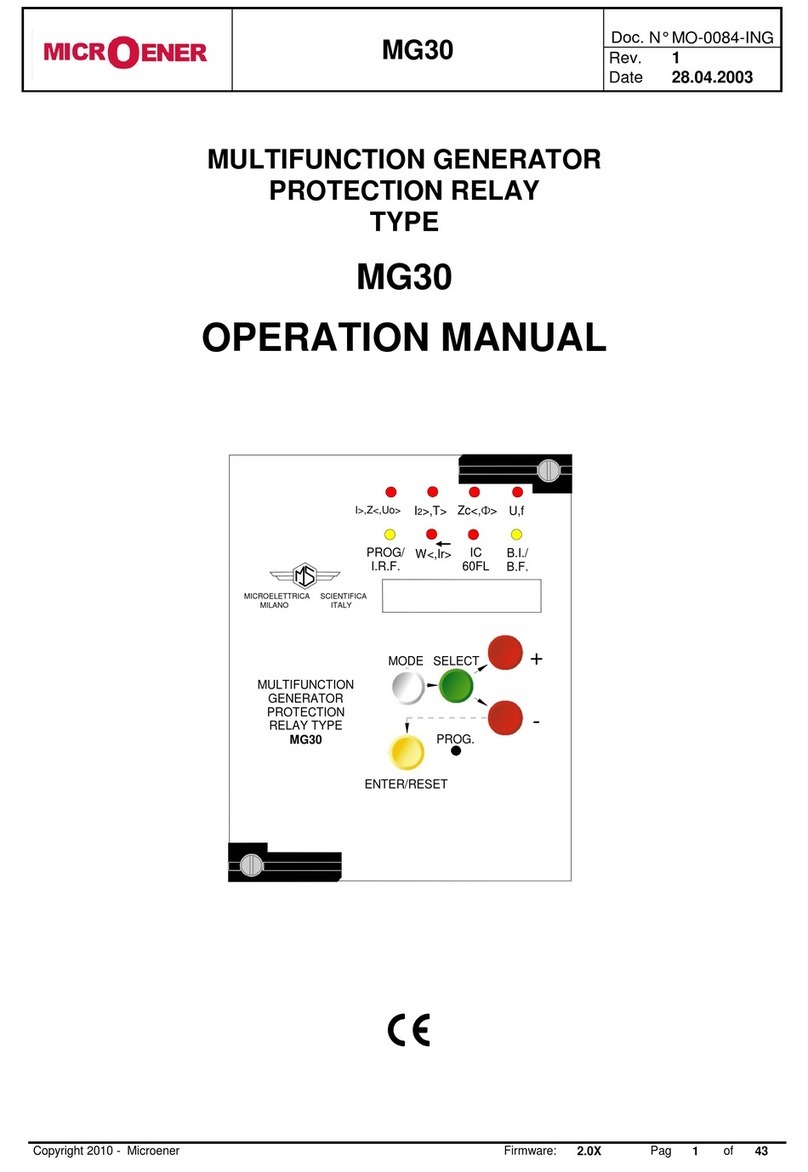
MICROENER
MICROENER MG30 User manual
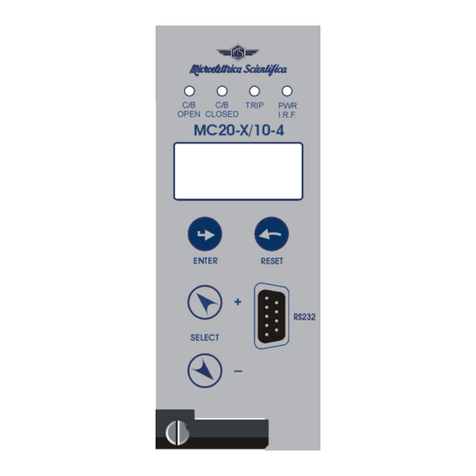
MICROENER
MICROENER MC20-X/10-4 User manual

MICROENER
MICROENER ELRC-1 User manual
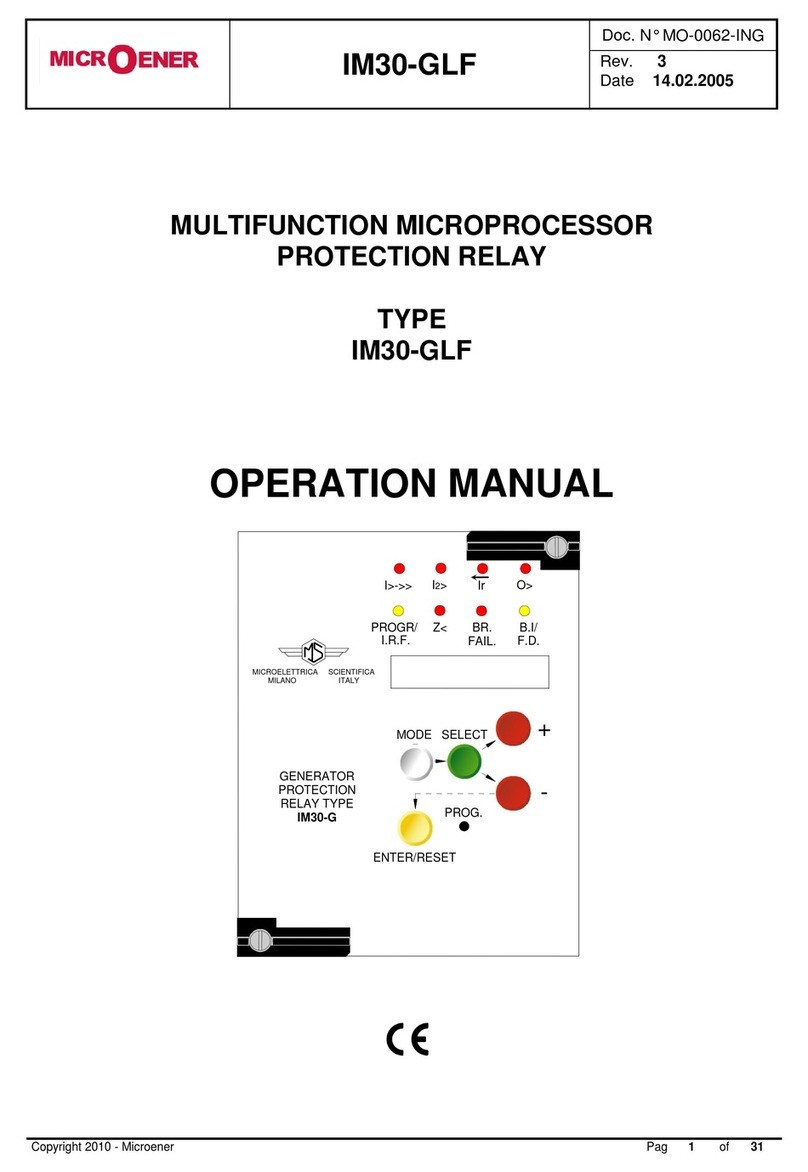
MICROENER
MICROENER IM30-GLF User manual
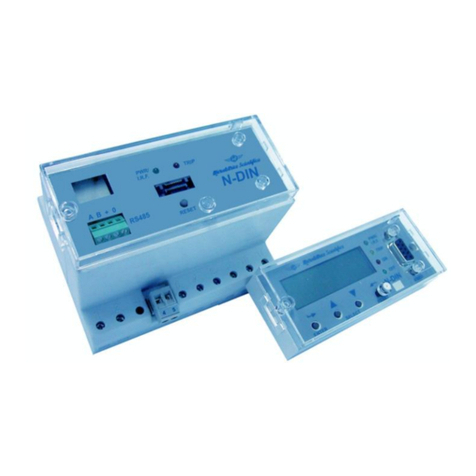
MICROENER
MICROENER N-DIN-MSG User manual
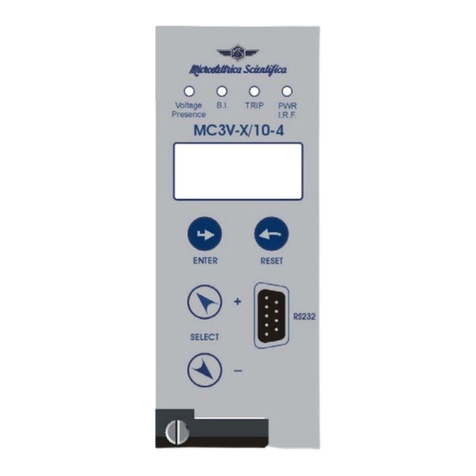
MICROENER
MICROENER MC3V-X/10-4 User manual
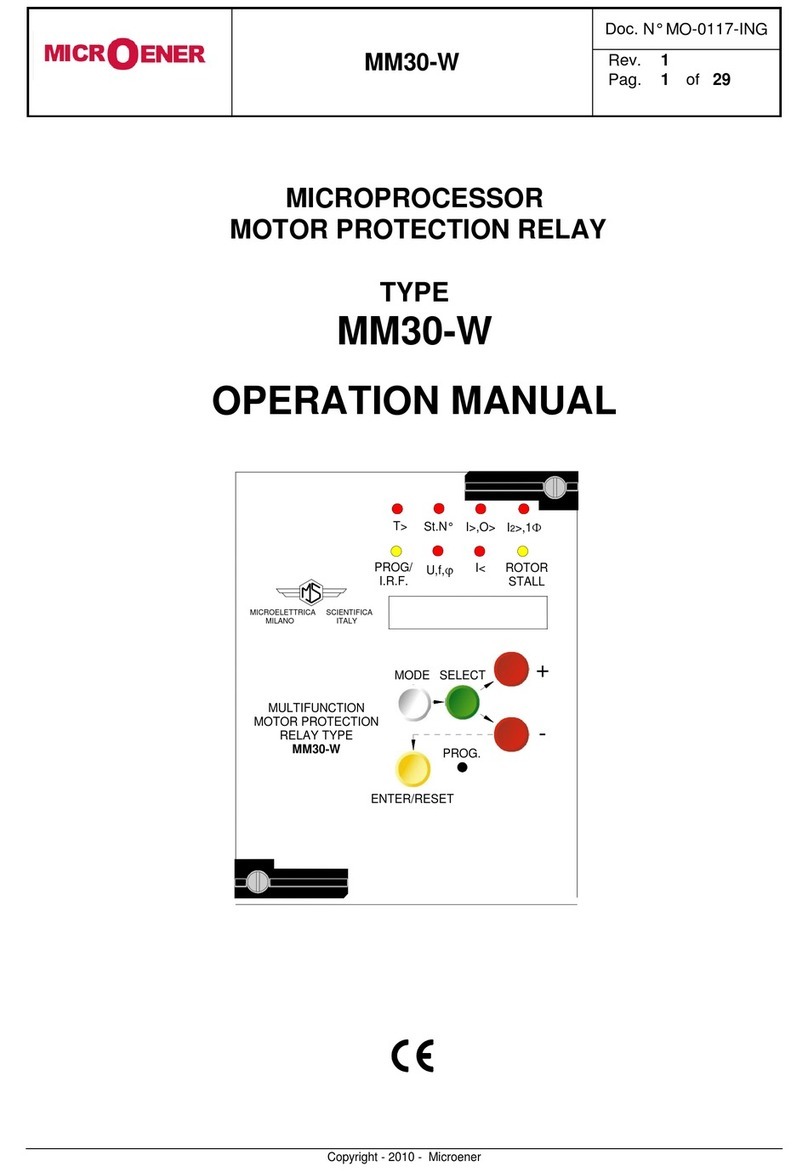
MICROENER
MICROENER MM30-W User manual
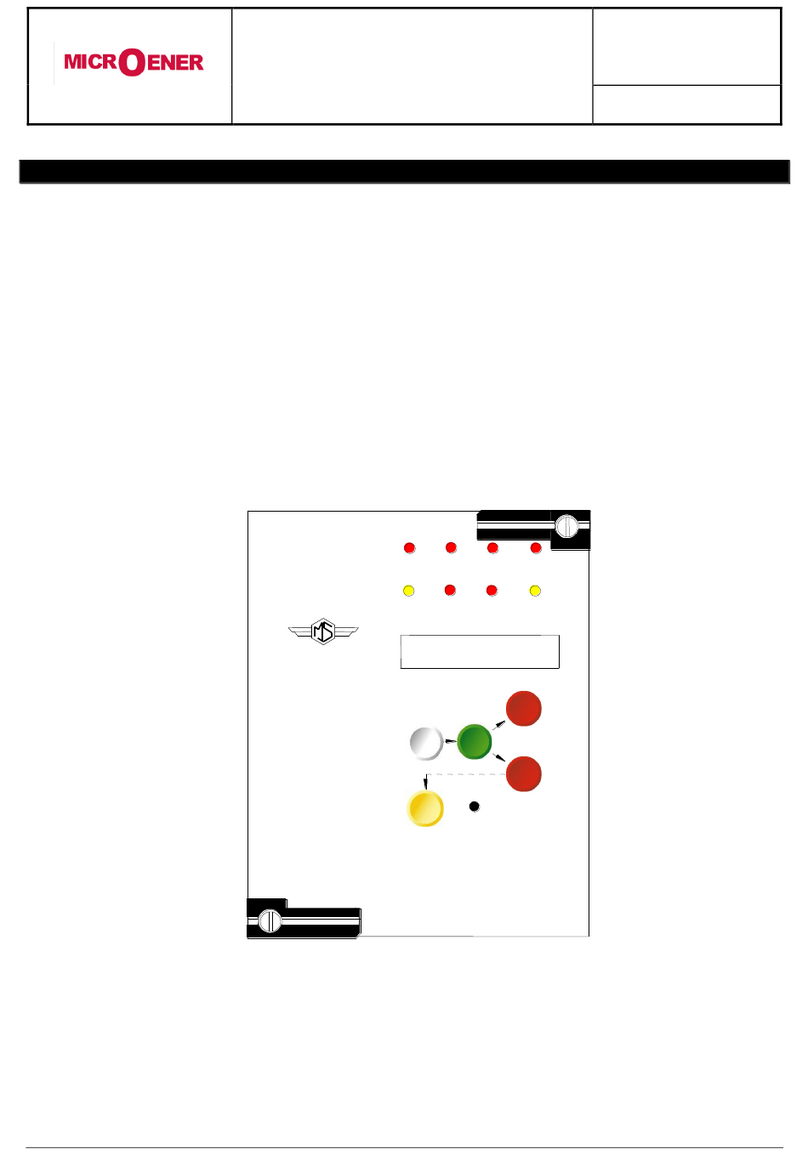
MICROENER
MICROENER M-LIB3 User manual
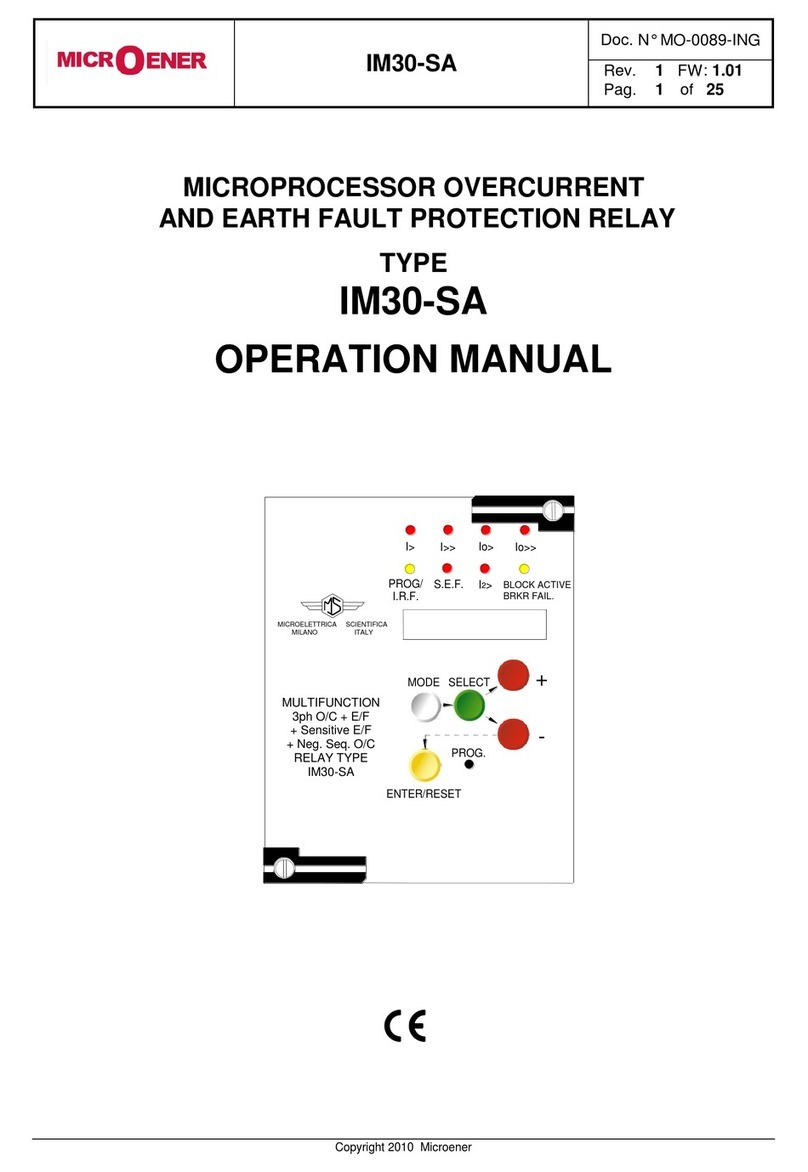
MICROENER
MICROENER IM30-SA User manual

MICROENER
MICROENER IM30-DK User manual


